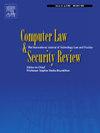A systematic literature review on dark patterns for the legal community: definitional clarity-and a legal classification based on the Unfair Commercial Practices Directive
IF 3.3
3区 社会学
Q1 LAW
引用次数: 0
Abstract
This article offers a clear definition of dark patterns and a comprehensive classification thereof using the framework provided by Directive 2005/29 on unfair commercial practices. The analysis builds on a systematic literature review that analyses how dark patterns are defined and the types of dark patterns discussed in 116 articles, conference papers and regulatory documents. Accordingly, 'dark pattern' can be defined as 'the design of a digital choice environment that is capable of distorting user behaviour'. We point out that the following elements should not be included in the definition of dark pattern: intentionality of the designer and exploitation of heuristics or cognitive bias. We identify 42 types of dark patterns. All of them can be classified as: misleading omission; misleading action; harassment; undue influence; coercion. This classification is based on legal categories and helps bridge the gap between research and legal practice, thereby increasing the expected social impact of research on dark patterns.
法律界对黑暗模式的系统文献回顾:定义的清晰度-以及基于不公平商业惯例指令的法律分类
这篇文章提供了一个明确的黑暗模式的定义,并使用指令2005/29关于不公平的商业行为提供的框架进行了全面的分类。该分析基于系统的文献综述,分析了黑暗模式的定义,以及116篇文章、会议论文和监管文件中讨论的黑暗模式的类型。因此,“暗模式”可以定义为“能够扭曲用户行为的数字选择环境的设计”。我们指出,以下因素不应包括在暗模式的定义中:设计者的意向性和启发式或认知偏见的利用。我们确定了42种黑色图案。所有这些都可以归类为:误导性遗漏;误导行动;骚扰;不正当影响;强制转换。这种分类以法律类别为基础,有助于弥合研究与法律实践之间的差距,从而增加对黑暗模式研究的预期社会影响。
本文章由计算机程序翻译,如有差异,请以英文原文为准。
求助全文
约1分钟内获得全文
求助全文
来源期刊
CiteScore
5.60
自引率
10.30%
发文量
81
审稿时长
67 days
期刊介绍:
CLSR publishes refereed academic and practitioner papers on topics such as Web 2.0, IT security, Identity management, ID cards, RFID, interference with privacy, Internet law, telecoms regulation, online broadcasting, intellectual property, software law, e-commerce, outsourcing, data protection, EU policy, freedom of information, computer security and many other topics. In addition it provides a regular update on European Union developments, national news from more than 20 jurisdictions in both Europe and the Pacific Rim. It is looking for papers within the subject area that display good quality legal analysis and new lines of legal thought or policy development that go beyond mere description of the subject area, however accurate that may be.

 求助内容:
求助内容: 应助结果提醒方式:
应助结果提醒方式:


